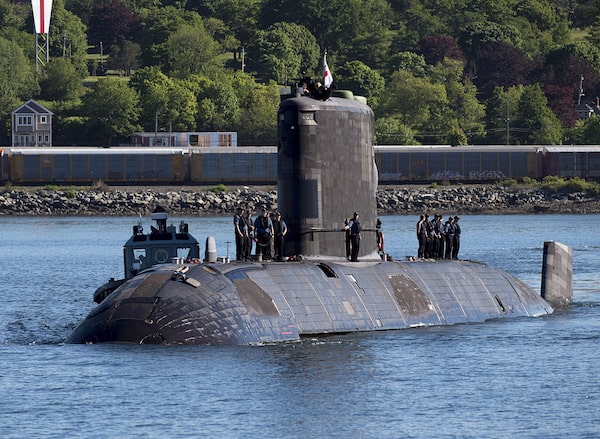
HMCS Windsor, one of Canada's Victoria-class long range patrol submarines, returns to port in Halifax on June 20, 2018. The clock is ticking for the Canadian military to decide whether to replace its submarines, as Canada's closest allies push ahead with plans to build new fleets.Andrew Vaughan/The Canadian Press
Canada is being advised to quickly replace its aging submarines with ones that can operate more effectively in the ice-bound Arctic, a region where the country’s top soldier has previously warned Ottawa only has a “tenuous hold” on its outer reaches.
The standing Senate committee on national security, defence and veterans affairs Wednesday called on Ottawa to outline a plan for “expeditiously replacing” Canada’s diesel-electric subs with versions that can patrol under the ice. The committee’s new report argues “increasingly aggressive behaviours by Russia and China have signalled a return to geopolitical competition” around the world.
“Canada urgently needs to enhance its ability to detect underwater threats,” the Senate report said. It also called for Ottawa to acquire underwater sensing technology.
Canada’s existing four submarines are refurbished models originally built by Britain in the 1980s and, unlike nuclear-powered subs, aren’t designed for under-ice operations.
Daniel Le Bouthillier, head of media relations at the Department of National Defence, said only one of Canada’s submarines is operational right now, meaning able to go on operations or exercises.
The report also recommends Canada make efforts to join the non-nuclear component of AUKUS, a security pact between Australia, Britain and the United States that was struck to counter China’s rising military might in the Indo-Pacific region. This non-nuclear part of AUKUS provides for information-sharing and close co-operation on accelerating development of cutting-edge technologies, including undersea defence capabilities, artificial intelligence, quantum technology and hypersonic warfare.
The Globe and Mail first reported in May, citing government sources, that Canada is seeking to join this second pillar of AUKUS.
Under the first pillar of AUKUS, the U.S. is sharing nuclear-propulsion technology with Australia, as it has with Britain for more than half a century. New submarines will be built for the British and Australians using a combination of British submarine design and U.S. technology. But the information-sharing aspect of the second pillar of AUKUS is seen as increasingly significant by analysts.
The Senate committee’s work builds on earlier analysis of Canada’s defence shortcomings in the Arctic, including a 2022 report by the Auditor-General that found Ottawa lacks a complete picture of who is entering or traversing Arctic waters and warned of significant gaps in this country’s ability to detect foreign or domestic ships in the Arctic. This means Canada can’t stay on top of threats to national security, illegal fishing or pollution from ships entering the region.
Last fall, General Wayne Eyre, the Chief of the Defence Staff, warned MPs that this country’s hold on its Arctic region will come under increasing challenge in the decades ahead as China and Russia expand their presence in the region.
Gen. Eyre told MPs Canada needs better underwater presence to track foreign activity, as well as an increased capacity to move troops there if necessary. “Our hold on our Arctic would be much more secure with greater subsurface domain awareness at sea and with greater capacity to deploy forces from the south strategically and efficiently on land,” Gen. Eyre said.
The general emphasized he saw no present threat to Canadian Arctic territory, but cautioned this could change down the road, saying Canada needs to make investments early enough to be ready.
Philippe Lagassé, an associate professor at Carleton University whose past research has focused on defence policy and procurement, said Arctic-capable submarines are the “missing piece” of recent efforts by Canada to upgrade its military capabilities.
Canada has committed to buying F-35 combat aircraft, and committed billions of dollars to help fund upgrades to pay for North America’s air defences, addressing the growing threat posed by hypersonic missiles and advanced cruise missile technology developed by Russia and China.
Mr. Lagassé said Canada should make it a priority to have submarines that can operate in Arctic waters year-round.
“Look at the number of icebreakers that are being built by the Chinese, by Russia, and even the fact that the Americans operate up there, with their nuclear powered submarines, and Canada has no year-round surveillance and defence capabilities against adversary submarines in the Arctic,” he said. “All that feeds into the reality that these are contested waters, and we have limited visibility in terms of who’s actually up there.”
In the late 1980s, the Canadian government proposed buying nuclear-propelled submarines capable of operating under Arctic ice but jettisoned the idea as the Cold War wound down.
The Senate report noted that Canada needn’t buy nuclear subs because another emerging technology – air-independent propulsion – could allow diesel-electric submarines to operate under Arctic ice.